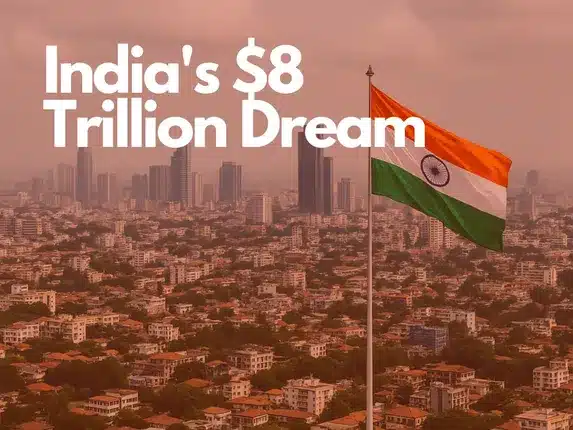India’s Path to an $8 Trillion Economy by 2035: Key Challenges Ahead

India is on a promising trajectory to become an $8 trillion economy by 2035, according to a recent report titled “The Great Unlock: India in 2035,” authored by Nandan Nilekani, co-founder and chairman of Infosys. However, the report identifies significant challenges that must be addressed, including rising income inequality, low formalization of the workforce, limited market access, and low productivity levels. Currently, a mere 13 out of 788 districts contribute to half of the country’s GDP, highlighting the uneven distribution of economic growth.
Challenges to Economic Growth
The report outlines four critical hurdles that India must overcome to achieve its ambitious economic goals. Income disparity is a pressing issue, with the wealthiest 10% of the population earning nearly 60% of the total income. This inequality has led to approximately 200 million workers migrating from less affluent states in search of better job opportunities. Additionally, India’s labor productivity is concerning, standing at just $7 per hour, which is about one-tenth of the productivity levels seen in the United States. The informal sector employs around 85% of the workforce, and many micro, small, and medium enterprises (MSMEs) struggle with formalization, limiting their access to credit and growth opportunities.
Digital Transformation as a Catalyst
Despite these challenges, the report expresses optimism regarding India’s future, primarily driven by rapid advancements in digital technology. Key infrastructure initiatives, such as Aadhaar, the Unified Payments Interface (UPI), and the Account Aggregator system, have significantly bolstered the digital economy. Monthly digital transactions have surged from zero to an impressive 16 billion, while Aadhaar-enabled services have drastically reduced identity verification costs from $23 to just 50 cents. The integration of artificial intelligence (AI) with Digital Public Infrastructure (DPI) is expected to connect the next billion Indians, enhancing accessibility to digital services for farmers, MSMEs, and students.
By 2035, it is anticipated that half of India’s workforce will be “AI-native,” with women’s participation in the labor force projected to rise from 25% to 47%. This digital revolution is not only creating new job opportunities but also formalizing employment across both rural and urban areas.
Addressing Structural Issues for Sustainable Growth
To maintain this growth momentum, the report emphasizes the need for India to improve access to capital, support small businesses, promote AI utilization, and simplify the monetization of land and property assets. A separate report by Ionic Wealth highlights that India’s export potential remains largely untapped due to low labor productivity and deficiencies in high-tech infrastructure. Despite being the world’s fifth-largest economy, India ranks only eighth in global merchandise exports, indicating that persistent bottlenecks continue to hinder growth.
Nevertheless, strong investment inflows, increasing foreign direct investment (FDI), and emerging sectors such as electric vehicles, electronics, and green energy present positive indicators for the future. India’s Purchasing Managers’ Index (PMI) remains robust among key Asian economies, suggesting a strong manufacturing sector. If these structural challenges are effectively addressed, India’s digital economy could unlock substantial growth, paving the way for the nation to realize its goal of becoming an $8 trillion economy by 2035.
Observer Voice is the one stop site for National, International news, Sports, Editor’s Choice, Art/culture contents, Quotes and much more. We also cover historical contents. Historical contents includes World History, Indian History, and what happened today. The website also covers Entertainment across the India and World.

